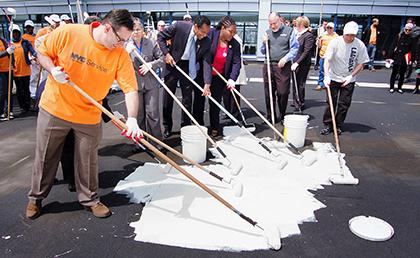BY CHAUNCEY ALCORN
As summer approaches and the weather heats up, New York City and Con Edison officials are planning to keep the city and parts of Queens cool while lowering energy costs using a new, green-technology program called Cool Roofs, which was developed in Long Island City.
The program is a city initiative recently started to encourage building owners to change their rooftops’ colors from black to white, using paint or a special coating, or covering their roofs with plants because these materials absorb less sunlight than blacktop surfaces. This helps combat what researchers call “heat island effect.” The result is cooler buildings, which researchers said can actually keep the city cooler.
“Heat island effect takes place when dark roofs absorb light during the day and radiate the heat back into the atmosphere during the night,” Con Ed spokesman Allan Drury said. “We’ve decided as a company to do whatever we can to preserve the environment and the Cool Roofs program is one of those measures.”
City Department of Buildings spokesman Tony Sclafani said because of heat island effect, temperatures in urban areas like Manhattan are typically higher than in more suburban areas.
“When you cool your roof and coat it with a reflective white coating, you not only can reduce a building’s energy costs, but also reduce the temperature in your neighborhood,” he said.
A team of researchers led by Columbia research scientist Stuart Griffin recently completed the study at Con Ed’s Learning Research Center in Long Island City. They discovered a cool roof can reduce air-conditioning costs by 50 percent in a one-story building and 25 percent in a two-story building.
“A cool roof absorbs 80 percent less heat than a traditional dark-colored roof and can lower in-door temperatures by up to 20 degrees on a hot day,” Sclafani said. “By decreasing the temperature, a cool roof can lower electrical bills and reduce energy consumption, and that can help reduce the likelihood of blackouts and brownouts. So that’s the impact. It’s making our city more [energy] efficient.”
Con Ed ha already converted several of its Queens facilities from black to white or green using plants, including a service center in College Point, and a total of three substations in Newtown, north Queens, and Jamaica. Using plants instead of white materials is more efficient and helps insulate buildings in the winter, but it is also more expensive, according to Drury.
“The [Learning Center] roof has a green section and a white section,” he said. “The green roof reduces heat gains by up to 84 percent and winter heat losses by up to 37 percent compared to black roofs.”
Sclafani said the city offers some incentive for property owners who participate in the program.
“If you are a property owner that would like to participate, you call 311 and you can purchase coating at reduced rates,” he said. “If a nonprofit organization is involved in the coating, the Community Environmental Center will help coordinate the entire coating for you.”
Reach reporter Chauncey Alcorn by e-mail at calcorn@cnglocal.com or by phone at 718-260-4564.






























